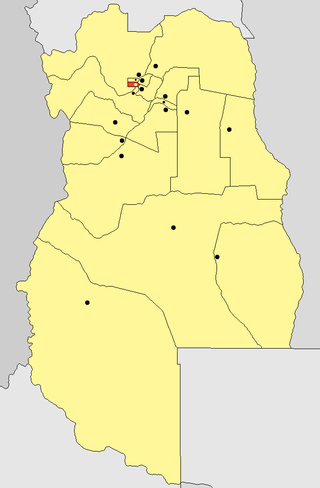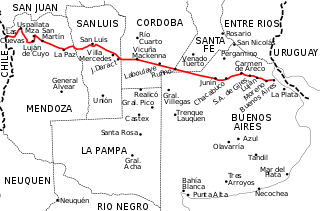
The geography of Argentina describes the geographic features of Argentina, a country located in the Southern Cone of South America. Bordered by the Andes in the west and the South Atlantic Ocean to the east, its neighbouring countries are Chile to the west, Bolivia and Paraguay to the north, and Brazil and Uruguay to the northeast.

Mendoza, officially Province of Mendoza, is a province of Argentina, in the western central part of the country in the Cuyo region. It borders San Juan to the north, La Pampa and Neuquén to the south, San Luis to the east, and the republic of Chile to the west; the international limit is marked by the Andes mountain range. Its capital city is the homonymous city of Mendoza.

Mendoza, officially the City of Mendoza is the capital of the province of Mendoza in Argentina. It is located in the northern-central part of the province, in a region of foothills and high plains, on the eastern side of the Andes. As of the 2010 census [INDEC], Mendoza had a population of 115,041 with a metropolitan population of 1,055,679, making Greater Mendoza the fourth largest census metropolitan area in the country.
Departments form the second level of administrative division, and are subdivided in municipalities. They are extended in all of Argentina except for the Province of Buenos Aires and the Autonomous City of Buenos Aires, the national capital, each of which has different administrative arrangements.

National Route 40, also known as RN40 or "Ruta 40", is a route in western Argentina, stretching from Punta Loyola near Rio Gallegos in Santa Cruz Province in the south to La Quiaca in Jujuy Province in the north. The route parallels the Andes mountains. The southern part of the route, by now largely paved, has become a well-known adventure tourism journey, and there are plans to pave the whole road.

San Rafael is a city in the southern region of the Mendoza Province, Argentina. With more than 118,000 inhabitants, it is the largest city in and the seat of San Rafael Department.

Tunuyán is a city in the west of the province of Mendoza, Argentina, located on the western shore of the Tunuyán River, 80 km (50 mi) south from the provincial capital Mendoza and 100 km (62 mi) east of the Chilean border. It has 49,132 inhabitants, and is the head town of the Tunuyán Department. Along with the Tupungato Department and the San Carlos Department it makes up the "Valle de Uco" region, which is famous in the Argentine wine industry for its important and modern vineyards and wineries. Investments since the millennium, attracted by the climate, soil, and altitude combination, have transformed the area, making it one of Argentina's most important regions when it comes to high-quality wine production and its associated connoisseur-driven enotourism.

Berisso Partido is a small eastern partido of Buenos Aires Province in Argentina.

Exaltación de la Cruz Partido is a partido in the north-east part of Buenos Aires Province in Argentina.

Monte Hermoso Partido is a partido on the Atlantic coast of Buenos Aires Province in Argentina.

General Alvear is a department located in the south east of Mendoza Province in Argentina.

Godoy Cruz is a central department of Mendoza Province in Argentina.

Guaymallén is a central department of Mendoza Province in Argentina.

Lavalle Department is a department located in the northeast of Mendoza Province in Argentina.

Rivadavia is a central department of Mendoza Province in Argentina.

San Martín is a department located in the centre of Mendoza Province in Argentina.

Salinas de Garci Mendoza is a town in the Bolivian Oruro Department. It is the administrative center of Ladislao Cabrera Province and is located 280 km (170 mi) south-west of Oruro, the capital of the department. It is situated at an elevation of 3,732 m (12,244 ft) at Caricha, 20 km north of the Tunupa stratovolcano. Salar de Coipasa,a salt lake, is 20 km north-west of Salinas de Garci Mendoza, and 15 km in south-eastern direction is Salar de Uyuni, the world's largest salt pan. Salinas de Garci Mendoza is the endpoint of the road from Chuquichamba via Andamarca and Aroma to Salinas de Garci Mendoza.

National Route 7 is a road in Argentina. It crosses the country from east to west, from the capital to the border with Chile, thus linking the Atlantic coast with the Andes, crossing the provinces of Buenos Aires, Santa Fe, Córdoba, San Luis and Mendoza. It has a total length of 1,224 km (761 mi), of which 367 km (228 mi) (30%) are freeways.

Sarmiento is a department located in the south west of San Juan Province in Argentina.

National Route 8 is a highway located in Argentina, that connects the provinces of Buenos Aires, Santa Fe, Córdoba and San Luis. The route starts at the link with National Route 9 in the northwest of Greater Buenos Aires, between the towns of El Talar, El Triángulo, Ricardo Rojas and Ingeniero Pablo Nogués, to the link with Provincial Route 55 in Villa Mercedes, San Luis Province at 695 km (432 mi).



















